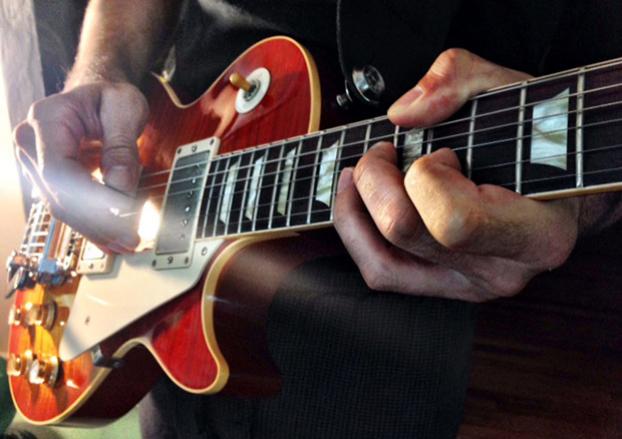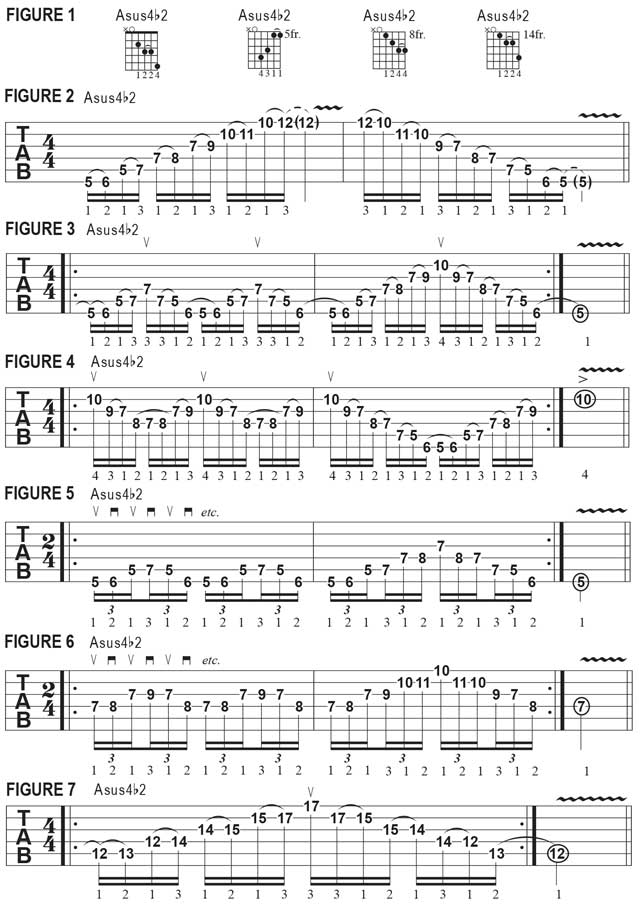Eerie Arpeggios, Part 4: The Spooky Sus4b2 Sound

In our last six lessons (see Guitar World May through September 2017), I presented a handful of unusual, intriguing four-note arpeggios in the key of A—Aadd2, Am(add2), Aaddb2, A6b2 and A7#9—and demonstrated some interesting ways to employ them melodically and repurpose two of them harmonically, using Caddb2 (C Db E G) or C6b2 (C Db A C) to get an A7#9 sound (A C# E G B#).
Continuing our exploration of cool and unusual four-note shapes, I now present Asus4b2 (A Bb D E) and some neat things you can do with it on the guitar.
Like the Aaddb2 arpeggio (A Bb C# E) that we covered in the August 2017 installment of String Theory, Asus4b2 gives you your A root note, flatted second (or ninth), Bb, and perfect fifth, E.
But instead of the bright-sounding major third, C#, we get the suspended fourth, D, which imparts a feeling of suspense (a convenient coincidence, with the term “suspended”), as the arpeggio’s or chord’s basic quality is neither major nor minor, being noncommittal in that regard. This, combined with the eeriness of the b2 (or b9), Bb, yields a rather mysterious, haunting sound that’s great for scaring children and adults alike.
As a chord reference, FIGURE 1 illustrates some finger-friendly Asus4b2 grips on the top four stings, with the open A string included and the first shape additionally shown 12 frets higher. It’s an intriguing chord sound, eh?
FIGURE 2 demonstrates an effective way to convey this same sound melodically, by playing an Asus4b2 arpeggio as a compact, four-note cell (A Bb D E), using two notes per string, with the shape initially played on the bottom two strings then transposed up an octave on the middle two strings, then up another octave on the top two strings, forming a continuous pattern that moves diagonally up and across the neck and back, via position shifts, spanning a two-and-a-half-octave range.
I’m employing legato phrasing here, using every available hammer-on and pull-off in order to achieve a smooth, rolling sound, but feel free to try and alternate pick all the notes, starting on either a downstroke or an upstroke, or to just increase your “picking percentage” slightly.
All the latest guitar news, interviews, lessons, reviews, deals and more, direct to your inbox!
The key to applying any scale or arpeggio musically is to make the notes fit rhythmically into the context of the meter and tempo of the song or groove over which you’re playing. You need to explore and discover ways in which to “sculpt” and “quantize” note groupings so that they conform to your desired phrasing scheme. Oftentimes, this involves playing a shorter, “bite-size” segment of a longer pattern across a narrower pitch range, so that you can play a figure ascending and descending repeatedly, within one or two octaves, and have all the notes and accents fall neatly into groups of 16th notes, triplets or sextuplets—what I like to call “shred cells.”
FIGURES 3–6 offer some examples of this approach, using our diagonal Asus4b2 arpeggio pattern as a template. FIGURE 7 introduces a new and equally useful fretboard pattern, or “path,” for Asus4b2, this one beginning on the A string’s 12th fret and ascending two octaves. Transpose this and all previous examples in this lesson to the other important guitar keys, namely E, D and G, and also B, C and F.
Next time, I’ll show you an interesting variation on this four-note shape and some cool and highly useful ways to repurpose it harmonically to achieve other equally compelling chord and arpeggio sounds.

Over the past 30 years, Jimmy Brown has built a reputation as one of the world's finest music educators, through his work as a transcriber and Senior Music Editor for Guitar World magazine and Lessons Editor for its sister publication, Guitar Player. In addition to these roles, Jimmy is also a busy working musician, performing regularly in the greater New York City area. Jimmy earned a Bachelor of Music degree in Jazz Studies and Performance and Music Management from William Paterson University in 1989. He is also an experienced private guitar teacher and an accomplished writer.

